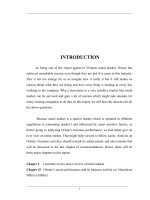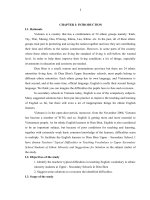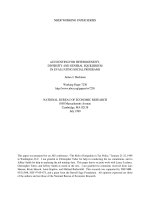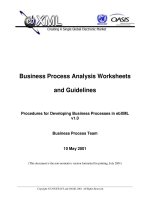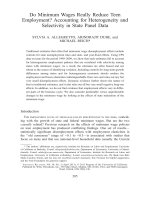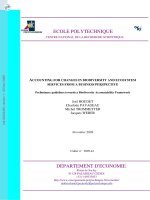accounting for sales and business result in hino motors vietnam, ltd and suggestions for improvement
Bạn đang xem bản rút gọn của tài liệu. Xem và tải ngay bản đầy đủ của tài liệu tại đây (1.27 MB, 89 trang )
MINISTRY OF FINANCE
ACADEMY OF FINANCE
Topic: “Accounting for sales and business result in HINO MOTORS
Vietnam, Ltd and suggestions for improvement”
GRADUATION THESIS
Major: English for Finance and Accounting
Hanoi, Year 2012
Student:
Hồ Thị Thùy Phương
Class:
CQ46/51.03
MINISTRY OF FINANCE
ACADEMY OF FINANCE
Topic: “Accounting for sales and business result in HINO MOTORS
Vietnam, Ltd and suggestions for improvement”
GRADUATION THESIS
Major: English for Finance and Accounting
Supervisor: MBA. Nguyễn Thị Thùy Trang
Hanoi, Year 2012
Student:
Hồ Thị Thùy Phương
Class:
CQ46/51.03
Graduation thesis
Hồ Thị Thùy Phương – CQ46/51.03
DECLARATION
I hereby declare that this thesis is my own work and effort and that has not
been submitted anywhere for any award. Where other sources of information have
been used, they have been acknowledged.
The data and results described in the thesis are derived from the actual
situation of the practice company.
Hanoi, 30 April, 2012
Student
Graduation thesis
Hồ Thị Thùy Phương – CQ46/51.03
ACKNOWLEDGEMENT
Firstly, I am deeply indebted to my supervisor MBA. Nguyen Thi Thuy
Trang whose help, stimulating suggestions and encouragement helped me all the
time of research for and writing of this thesis.
I also want to thank Hino Motors Vietnam, Ltd for giving me permission to
commence this thesis in the first instance, to do the necessary research work and to
use departmental data.
I have furthermore to thank the former Vice Director and Finance Manager
as well as all seniors at Hino Motors Vietnam, Ltd who gave and confirmed this
permission and encouraged me to go ahead with my thesis.
My friends from Foreign Language Faculty also supported me in my thesis. I
want to thank them for all their help, support, interest and valuable hints.
Especially, I would like to give my special thanks to my family whose
patient love enabled me to complete this work.
Finally, because of limitation of time and knowledge, mistakes are
unavoidable, so I wish to have more opportunities. I also wish to receive more
contribution and suggestions to make my thesis better.
Graduation thesis
Hồ Thị Thùy Phương – CQ46/51.03
ABSTRACT
In the modern economic world, especially when the number of bankrupt
enterprises is rising, accounting for sales and business result has become more and
more important, for every company in general, and for Hino Motors Vietnam, Ltd
in particular. Therefore, my thesis with the topic “Accounting for sales and
business result in Hino Motors Vietnam, Ltd and suggestions for improvement”
will point out the importance of having a healthily and effective accounting
department for sales and business result.
The main content is reflected in three chapters. The first chapter is about the
literature review for every company, mainly showing what accounts are involved
in calculating business result, its definitions and accounting entries. In chapter 2,
by taking a scenario in Hino Motors Vietnam, Ltd, the thesis focuses on a real
accounting practice for sales and business result. From that, chapter 3 points out
the company’s strengths and weaknesses and suggests some solutions to improve
the current accounting system in Hino Motors Vietnam, Ltd.
In conclusion, the thesis has already been complete in comparison with
proposed objectives and targets in the introduction.
Graduation thesis
Hồ Thị Thùy Phương – CQ46/51.03
LIST OF ABBREVIATIONS
No.
Abbreviation
Full phrase
1
Acc
Account
2
COGS
Cost of goods sold
3
Deprec
Depreciation
4
Dept
Department
5
HMV
Hino Motors Vietnam
6
IS
Income Statement
7
MKS
Mankichi Kanjo System
8
No.
Number
9
P&L
Profit and Loss
10
Q’ty
Quantity
11
VAS
Vietnamese Accounting Standard
12
VAT
Value Added Tax
Graduation thesis
Hồ Thị Thùy Phương – CQ46/51.03
TABLE OF CONTENT
Part I: Introduction 1
1. Rationale 1
2. Aims of the study 1
3. Subject and scope of the study 2
4. Introduction of the main content 2
Part II: Main content 3
Chapter 1: Literature Review 3
1.1 Overview 3
1.1.1 Characteristics of goods 3
1.1.2 Managerial requirements 3
1.1.3 Funtions of accounting for sales and business result 4
1.1.4 Methods of sales 5
1.2 Accounting entries for sales and business result 6
1.2.1 Accounting for Cost of Goods Sold (COGS) 6
1.2.2 Accounting for Sales and Sales Deductions. 8
1.2.3 Accounting for Selling and Administration expenses 11
1.2.4 Accounting for Financial Expenses and Incomes 12
1.2.5 Accounting for Other Expenses and Incomes and Corporate Income
Tax Expense. 13
1.2.6 Accounting for business result 14
1.3 Preparing financial statements 15
1.4 Systems of Accounting forms 15
1.5 Computerized accounting for sales and business result 17
Chapter 2: Current situation of accounting for sales and business result in
HINO MOTORS Vietnam, Ltd 18
2.1. Overview about Hino Motors Vietnam, Ltd 18
2.1.1. History 18
2.1.2. Business field and products 18
2.1.3. Organizational structure. 19
Graduation thesis
Hồ Thị Thùy Phương – CQ46/51.03
2.1.4. Characteristics of accounting department 19
2.2. Current situation of accounting for sales and business result in Hino
Motors Vietnam, Ltd. 21
2.2.1. List of main products 21
2.2.2. Main selling method at Hino Motors Vietnam, Ltd 22
2.2.3 Current situation of accounting for sales and business result 23
2.2.3.1 Accounting for Cost of Goods Sold (COGS) 23
2.2.3.2 Accounting for Sales and Sales Deductions 26
2.2.3.3 Accounting for Selling and Administration Expenses 32
2.2.3.4 Accounting for Business result 36
2.2.3.5 Income Statement 38
2.3 General conclusion about accounting performance for sales and
business result in Hino Motors Vietnam, Ltd 39
Chapter 3: Some suggestions for improving the accounting system for sales
and business result in HINO MOTORS Vietnam, Ltd 40
3.1 Evaluation of accounting for sales and business result in Hino Motors
Vietnam, Ltd 40
3.1.1 Strong points 40
3.1.2 Weaknesses 41
3.2 Importance and requirements for improving the accounting system for
sales and business result. 42
3.2.1 Importance 42
3.2.2 Requirements 43
3.2.3 Orientation 43
3.4 Some suggestions for improving the accounting system for sales and
business result in Hino Motors Vietnam, Ltd 45
3.3.1.Updating the accounting software 45
3.3.2 Allocating tasks effectively to accountants 45
3.3.3.Opening third-level accounts 46
3.3.4.Improving the Sales Discount accounts. 47
Graduation thesis
Hồ Thị Thùy Phương – CQ46/51.03
3.3.5.Improving the preparation of accounting reports 47
Part III: Conclusion 51
References
Appendixes
Graduation thesis
Hồ Thị Thùy Phương – CQ46/51.03 Page 1
Part I: Introduction
1. Rationale
In this modern economic world with many newly established enterprises
which follows a more competitive economic environment, every company must
be flexible and active in their businesses, make as many profits as possible; else
they will fall into bankruptcy. In order to gain profits, they must realize the
importance of sales and distribution phase because of its creating incomes to
offset incurred expenses, then determining the profitability of the company.
Besides, the very first objective of every enterprise is making a profit, so
calculating business result in general and sales revenue in particular is very
important in both forms of accuracy and timeliness. It’s the reason why efficient
and effective accounting management for sales and business result plays an
important role in the accounting system.
Hino Motors Vietnam, Ltd is a manufacturer of heavy and medium – sized
trucks. This field is rather new in Vietnam with competitive markets. It is now
one of leading companies in this field. Therefore, maintaining its current position
and being the market leader is more important than ever.
From this situation, Hino Motors Vietnam, Ltd must have a flexible and
effective sales campaign with a well-performed accounting system for sales and
business result. Because of the importance of accounting for sales and business
result, I chose “Accounting for sales and business result in HINO MOTORS
Vietnam, Ltd and suggestions for improvement” as my graduation thesis topic.
2. Aims of the study
My study has three objectives:
First, it is to contribute to the background theory of accounting for sales and
business result, which is done by pointing out definitions, accounts used and
accounting entries for each account related to determining business result in a
manufacturing company.
Graduation thesis
Hồ Thị Thùy Phương – CQ46/51.03 Page 2
Second, it is to illustrate how a company does accounting for sales and
business result by taking the scenario at Hino Motors Vietnam, Ltd as a case for
study.
Third, it is to review the company’s achievements and limitations and to
suggest possible solutions to improve the accounting performance for sales and
business result in the future.
3. Subjects and scope of the study
3.1 Subjects of the study
My study mainly focuses on sales, selling expenses, administration expenses,
some other related expenses and incomes, and net income – their definitions,
accounts used to do accounting and accounting entries.
Besides, it is also about preparing accounting reports in which net income
and retained earnings are reflected.
3.2 Scope of the study
- Time: Accounting fiscal year from 1/4/2009 to 21/12/2012 (Quarter III of
the fiscal year form 1/4/2011 to 31/3/2012)
- Space: Hino Motors Vietnam, Ltd
4. Introduction of the main content
Apart from the introduction, conclusion, references and documents attached,
the main content is divided into three chapters as follows:
Chapter 1: Literature Review
Chapter 2: Current situation of accounting for sales and business result in
HINO MOTORS Vietnam, Ltd
Chapter 3: Some suggestions for improving the accounting system for sales and
business result in HINO MOTORS Vietnam, Ltd
Graduation thesis
Hồ Thị Thùy Phương – CQ46/51.03 Page 3
Part II: Main content
Chapter 1: Literature Review
1.1 Overview
1.1.1 Characteristics of goods
In general, goods are finished products of the final manufacturing stage and
have been approved to be qualified to put in stock or sell.
Different goods, in different types, have some following characteristics:
- Goods are finished products of the final manufacturing stage by the
manufacturer itself or by outsourcing.
- Finished products are considered as goods only after being approved to
be qualified.
- Goods have to be put into stock.
Goods includes finished goods, semi-finished goods (or work-in-process),
materials and services to customers. Among them, finished goods are the main
products of a manufacturing company.
To have more understanding, we must distinguish between finished goods
and products:
Items
Finished goods
Products
Level
of
limit
Finished goods are the final result of a
certain manufacturing process with a
certain technology in a company-scope.
Products are results of manufacturing
and service providing process in
general.
Scope
The concept of product is larger than finished goods, because products include both
finished goods and semi-finished goods
1.1.2 Managerial requirements for accounting for sales and business result
Sales are the transfer of the goods usage right attached with the decision-
making power from the seller to the buyer. In addition, sales are recognized when
the customer makes payment or agrees to pay.
Sales are in the final stage of a business process. It is the transfer of capital
form, from capital in products to capital in monetary or in payment. Therefore, the
Graduation thesis
Hồ Thị Thùy Phương – CQ46/51.03 Page 4
faster the sales process happens, the shorter the business cycle is, the faster the
capital turnover is, and the more profit it brings to the company.
When a sales takes place, the company gains revenue and other incomes
which are the total economic benefits for the company in the accounting period.
Besides, some expenses must be paid, which decreases the economic benefits of the
company in the same period. These expenses include out-of-pocket money and
deductions such as discounts.
After a sales process, the company must determine the business result, by
comparing incomes with expenses. Afterwards, the net income will be allocated
effectively as targeted and as regulated.
If the company only has one revenue gain and one expense payment, it does
not need any sales management. However, almost all companies have more than
one transaction each day. Therefore, in order to be well managed, the company
must have a single department to record, track, and report all of the sale transactions
daily. From these requirements, accounting for sales and business result is
established.
1.1.3 Functions of accounting for sales and business result
In order for requirements of managing goods, sales, determination of
business result and division of net income to be met, accounting for sales and
business result has to execute some following missions of:
- Fully, timely, accurately reflecting and recording occurred transactions
and movements of each type of goods and products under quantity,
quality, model and value;
- Fully, timely, accurately reflecting and recording sales, sales deductions
and expenses of each business activity, as well as following and
supervising customers’ receivables;
- Accurately calculating and reporting results of each transaction;
- Monitoring the implementation of state obligations and division process
of business result;
Graduation thesis
Hồ Thị Thùy Phương – CQ46/51.03 Page 5
- Interpreting accounting reports to information users. Accounting
information must be accurate, easy-to-read and useful.
Therefore, accounting for sales and business result must follow current
regulated accounting standards, as well as be adaptable with the current status of the
company’s accounting system.
Besides, if carried out effectively, these above professions will put a hand
into increasing the accounting productivity in general. Thanks to that, accounting
information will be helpful for directors and managers in making sound decisions,
which will raise the business profitability.
1.1.4 Methods of sales
Sales is the process of delivering goods to customers. There are two typical
methods of sales, including direct sales and sales through agents (consignment
sales).
1.1.4.1 Direct sales
Direct sales is the method of delivery to the buyer directly at the warehouse
of the enterprise. Goods when delivered to customers must be paid or agreed to pay.
After this package of goods is brought out of stock, the seller company will lose the
ownership power of such goods. This method includes whole sales and retail sales.
- Whole sales: is the method of delivery of goods to manufaturing and/or
trading companies to put into the producing process as input materials or to
consigned for sales or sell directly. Therefore, the wholesalers are very various,
such as domestic or foreign or join-venture manufacturers, traders, or even private
enterprises. Chracteristics of whole sales:
The most typical characteristic is that goods are still in distribution phase, not in
consumption.
Secondly, goods are often bought in large quantity and in different kinds of
payment.
Before a sale, the buyer will assign someone to be at the seller’s warehouse.
During the sales, the assigned person will check the quantity, quality, model and
value of the goods package, and sign in realted vouchers and invoices. After that,
when the buyer pays or agrees to pay (with valid documents and signatures), the
Graduation thesis
Hồ Thị Thùy Phương – CQ46/51.03 Page 6
buyer will record the transaction as sales revenue as well as state obligations (such
as output VAT).
Accountants use VAT Invoices, Sales Contract and Delivery Orders set by the
company. This VAT Invoice may have 3 or 5 Copies (Liens) dependent on the
company’s requirements.
- Retail sales: is the method of delivery of goods direclty to the end
consumers – the final destination of the distribution phase. The retailers are all
Vietnamese citizens or foreigners, regardless of their class and nationality.
Characteristics of retail sales:
Goods are in consumption phase, not in distribution. The usge value of goods are
being implemented.
Retail goods are often bought in small quantity, and with immediate payment,
usually in cash.
1.1.4.2 Sales through agents (Consignment sales)
It is the method of delivery through the channel of agents. Different from
direct sales, after the package of goods is brought out of stock, it still belongs to the
company and is not considered to be in consumption phase. The company only
records sales revenue when the agent reports to sell such goods. When goods are
sold, the company must pay commissions for the agent which is considered as a
selling expense.
Sales of goods on consignment for agents are recorded as sales revenue only
when:
- The company has received money payment from the customers;
- The customer has received his package of goods and agrees to pay;
- The customer has advanced the amount of purchase payment of the
package of goods;
- The package of goods on consignment is paid via bank.
1.2 Accounting entries for sales and business result
1.2.1 Accounting for Cost of goods sold (COGS)
1.2.1.1 Definition
Graduation thesis
Hồ Thị Thùy Phương – CQ46/51.03 Page 7
Expense of finished goods and merchandise goods sold (shortly called cost of
goods sold) is the expense of goods determined at the time they are sold out.
According to VAS 2 - Inventory, cost of goods sold can be calculated by the
following methods:
- Specific identification method
- Average expense method
- First-in, First-out method
- Last-in, First-out method
1.2.1.2 Calculating COGS
Cost of goods
sold (COGS)
=
Expense of
Goods out of
stock
+
Selling
Expenses
+
Administration
Expenses
For manufacturing companies: The value of goods for sale from stock or
finished goods for direct sales not through warehouse is considered as cost of goods
sold.
1.2.1.3 Accounting entries for Cost of goods sold (COGS)
For sales through agents (consignment sales)
Accounts used
157 – Goods on consignment. This account reflects the current available amount
and changes of value of goods on consignment. The ending balance of this account
determines the volume of goods which are not in consumption (which means the
goods are in the agent’s stock).
Others: 632 – Cost of goods sold, 156 – Finished goods…
Accounting entry
For perpetual inventory method (see Flowchart 01)
For periodic inventory method (see Flowchart 02)
For direct sales
Account used
Graduation thesis
Hồ Thị Thùy Phương – CQ46/51.03 Page 8
632 – Cost of goods sold. This account reflects the value of goods and services
which were sold and afterwards, the transfer of ending balance to account 911 – net
income
Others: 156 – Finished goods, 911 – Net income…
Accounting treatment
For perpetual inventory method (see Flowchart 03)
For periodic inventory method (see Flowchart 04)
1.2.2 Accounting for Sales and Sales Deductions
1.2.2.1 Accounting for Sales
1.2.2.1.1 Sales revenue
Types of revenues: Sales revenue; Revenue from rendering services;
Revenue from deposit interest, selling copyrights, dividends, and distributed profit;
and Revenue from trading real estates.
Sales revenue is the gross inflow of economic benefits during the period
arising in the course of the ordinary activities of an entity when those inflows result
in increases in equity, other than increases relating to contributions from equity
participants.
Net sales is determined by sales revenue after deducting sales deductions
including trade discounts, sale allowances, and sales returns.
1.2.2.1.2 Sales recognition principles
Sales revenue is recognized only when meeting all recognition conditions
stipulated in Vietnamese Accounting Standards (VAS) No. 14: Sales and other
incomes.
Revenue from the sale of goods shall be recognized when all the following
conditions have been satisfied:
The entity has transferred to the buyer the significant risks and rewards of ownership
of the goods;
The entity retains neither continuing managerial involvement to the degree usually
associated with ownership nor effective control over the goods sold;
The amount of revenue can be measured reliably;
Graduation thesis
Hồ Thị Thùy Phương – CQ46/51.03 Page 9
It is probable that the economic benefits associated with the transaction will flow to
the entity; and
The expenses incurred or to be incurred in respect of the transaction can be measured
reliably.
1.2.2.1.3 Accounting vouchers and invoices used
- VAT invoice
- Normal sales invoice
- Payment voucher of goods on consignment
- Other payment vouchers
1.2.2.1.4 Accounts used
- 511 – Revenue from sales of goods and rendering of services
- 512- Internal revenue
- 3331 – VAT payables
- 3387 – Deferred income
- Others: 111 – Cash on hand; 112 – Cash in bank; 131 – Account
receivables…
1.2.2.1.5 Accounting entries
For direct sales
For company applying deduction/subtraction VAT method (see Flowchart
05)
For company applying direct VAT method (see Flowchart 06)
For sales through agents (see Flowchart 07)
1.2.2.2 Accounting for Sales Deductions
1.2.2.2.1 Trade discount
- Definition: Trade discount is the amount of money that enterprise
credited or paid to customers who bought goods and services in large
volume in accordance with the agreement that the seller will give trade
discount to the buyer.
- Accounts used
521 – Trade discount. This account has no beginning and ending
balance.
Graduation thesis
Hồ Thị Thùy Phương – CQ46/51.03 Page 10
Others: 111, 112, 131, 3331…
- Accounting entry (see Flowchart 08)
1.2.2.2.2 Sales returns
- Definition: Sales return is the amount of goods sold which have
subsequently been returned due to the following reasons: breaching the
commitment or the economic contract, or in a wrong quantity, quality or
specifications.
- Accounts used
531 – Sales return. This account reflects the volume of goods which
are returned due to the company’s mistakes. Account 531 has no
balance.
Others: 111, 112, 131….
- Accounting entry (see Flowchart 09)
1.2.2.2.3 Sales allowances
- Definition: Sales allowance is a reduction made when the goods are not
the same specification as those mentioned in the economic contract.
- Accounts used: 532 – Sales allowances. This account only reflects the volume
of sales allowances out of the VAT invoice according to the agreement between
sellers and buyers. Price deductions written in VAT invoices are not considered as a
sales allowance.
- Accounting entry (see Flowchart 10)
1.2.2.2.4 Tax payables (VAT, Export Duty, Excise Duty)
- Definition:
VAT (Value Added Tax) is an indirect tax calculated on the added/increased value
of goods and services, arising in the production, distribution and consumption phases;
Export duty is calculated by Custom Office on the price written in the export
contract at the border gate, usually FOB (Free On Board) price and export duty rate. This
price is exchanged into Vietnamese Dong according to the average exchange rate in the
inter-bank foreign exchange market, announced by SBV (State Bank of Vietnam) at the
time of exporting;
Graduation thesis
Hồ Thị Thùy Phương – CQ46/51.03 Page 11
Excise duty (also called Special Consumption Tax) is levied on the profit of some
special types of goods and services stipulated by the Government in order to limit the
consumption speed because these goods and services are unnecessary or harmful to life
such as wine, beer, cigarettes… The excise duty base is the price with export duty or
price without VAT.
- Accounts used
3331 – VAT payable
3332 – Excise duty payable
3333 – Custom duties payable
- Accounting entry (see Flowchart 11)
1.2.3 Accounting for Selling and Administration Expenses
1.2.3.1 Accounting for Selling Expenses
1.2.3.1.1 Definition:
Selling expenses are all expenses incurred in relation to selling process of
goods and services.
1.2.3.1.2 Content of selling expenses
Sale staff salary expense; Packaging and indirect material expense;
Depreciation expense; Warranty expense; Rendered services; and other expenses
1.2.3.1.3 Principles of collection and allocation of selling expenses
Selling expenses when actually incurred will be collected as selling expenses.
Besides, selling expenses can be collected as fixed and variable selling expenses. At
the end of the period, selling expenses will be transferred, allocated to determine
the business result. Allocation criteria may be cost of goods sold or sales revenue.
1.2.3.1.4 Accounts used
- 641 – Selling expenses. This account has no balance.
- Others: 111, 131, 334, 152…
1.2.3.1.5 Accounting entry (see Flowchart 12)
1.2.3.2 Accounting for Administration Expenses
1.2.3.2.1 Definition
Graduation thesis
Hồ Thị Thùy Phương – CQ46/51.03 Page 12
Administration expenses are all expenses incurred in relation to such
activities as businesses, administration management, and others which are carried
out in the company in general.
1.2.3.2.2 Content of administration expenses
Officer’s salary expense; Office tools; Depreciation; Tax, fees and charges;
Provision expense; Service rendered; and others
1.2.3.2.3 Accounts used
- 642 – Administration expenses. This account has no balance.
- Others: 111, 131, 334, 152…
1.2.3.2.4 Accounting entry (see Flowchart 13)
1.2.4 Accounting for Financial Expense and Income
1.2.4.1 Accounting for Financial Expense
1.2.4.1.1 Definition
Financial expenses are all expenses incurred in relation to financial activities
of the company, such as borrowings…
1.2.4.1.2 Contents of financial expenses
- Expenses related to financial investments such as: loss from investments,
other expenses which are not capitalized in the investments
- Borrowing expenses such as: interest
- Expenses related to foreign currencies translation, loss from foreign
exchange rate difference
- Provision for financial investments
- Other expenses related to financial activities
1.2.4.1.3 Accounts used
- 635 – Financial expenses. This account has no balance.
- Others: 111, 131, 334, 129…
1.2.4.1.4 Accounting entry (see Flowchart 14)
1.2.4.2 Accounting for Financial Income
1.2.4.1.5 Definition
Graduation thesis
Hồ Thị Thùy Phương – CQ46/51.03 Page 13
Financial incomes are all incomes gained in relation to financial activities of
the company, such as borrowings…
1.2.4.1.6 Contents of financial incomes
- Interest income such as: loan interest, deposit interest…
- Capital gain from disposing financial investments
- Distributed dividend and profit
- Gain from foreign exchange difference
- Payment discount
- Other financial incomes
1.2.4.1.7 Accounts used
- 515 – Financial incomes. This account has no balance.
- Others: 111, 131, 334, 129…
1.2.4.1.8 Accounting entry (see Flowchart 15)
1.2.5 Accounting for Other Expenses and Incomes and Corporate
Income Tax Expense
1.2.5.1 Accounting for Other Expenses
1.2.5.1.1 Content of other expenses
- Expenses from disposal and liquidation of fixed assets and their net book
value.
- Losses from revaluation of materials, goods and fixed asset which are
contributed in joint ventures, associates…
- Compensation for breaches of contracts;
- Tax penalty;
- Other expenses
1.2.5.1.2 Accounts used
- 811 – Other expenses. This account has no balance
- Others: 111, 112, 338, 211…
1.2.5.1.3 Accounting entry (see Flowchart 16)
1.2.5.2 Accounting for Other Incomes
1.2.5.2.1 Content of other incomes
Graduation thesis
Hồ Thị Thùy Phương – CQ46/51.03 Page 14
- Proceed of disposal of fixed asset;
- Gains from the revaluation materials, goods and fixed asset that are used
to contribute or invest into associates or other long-term investment;
- Gains from contract compensation by the customers;
- Tax refund from the State Budget;
- Accounts unidentifiable as to whom they are payable;
- Sales-related tips or awards (if any offered by suppliers which are not
included in sales)
- Gifts or donations in cash or in kind by organizations and individuals;
- Other incomes
1.2.5.2.2 Accounts used
- 711 – Other incomes. This account has no balance
- Others: 111, 112, 331, 3387…
1.2.5.2.3 Accounting entry (see Flowchart 17)
1.2.5.3 Accounting for Corporate Income Tax Expense
1.2.5.3.1 Content of corporate income tax expense
- Each quarter, based on the tax declaration, the accountant records
estimated current income tax into current income tax expense.
- At the end of fiscal year, if the estimated income tax is less than the
actual current income tax to be paid, the accountant should record
additional tax into current income tax expense. In case estimated income
tax is higher than actual income tax to be paid for the year, the
accountants should decrease the current income tax expense by the
difference between the estimated income tax and the actual income tax
payable.
- If the entity detects immaterial errors relating to income tax payable of
the previous year the accountants should record the increase or decrease
of the income tax payable of the previous year in current income tax of
the current year.
Graduation thesis
Hồ Thị Thùy Phương – CQ46/51.03 Page 15
- At the end of the fiscal year, the accountants should transfer the current
income tax to determine operation result
1.2.5.3.2 Accounts used
- 821 – Corporate income tax expense
1.2.6 Accounting for Business result
1.2.6.1 Definition
Business result is the final result of the normal activities and other activities
during the accounting period. Business result in a certain period may be profit or
loss. In case of loss, business result will be compensated as regulated and decided
by responsible authorities. In case of profit, business result will be allocated as
regulated by the financial regime.
1.2.6.2 Accounts used
- 911 – Net income
- 421 – Retained earnings
1.2.6.3 Accounting entry (see Flowchart 18)
1.3 Preparing financial statements
1.3.1 Preparing a balance sheet
Information related to accounting for sales and business result is displayed
under item Retained earnings, code 420
1.3.2 Preparing an income statement
Information related to accounting for sales and business result is displayed
under following items:
- Revenue from sales of goods and rendering of services, code 01
- Revenue deductions, code 02
- Net revenue from sales of goods and rendering of services, code 10
- Cost of goods sold, code 11
- Selling expenses, code 24
- Administration expenses, code 25
- Corporate income tax expense, code 51
- Profit after tax, code 60
Graduation thesis
Hồ Thị Thùy Phương – CQ46/51.03 Page 16
1.4 Systems of Accounting forms
There are 4 systems of accounting forms: General journal; Journal voucher;
General journal voucher; and Journal - Ledger.
1.4.1 General journal
- The most typical characteristic is that this system uses General journal
book to record all economic and financial activities in time order and in
the relationship with correspondent accounts, then uses information in
Genral journal to open related ledgers for related accounts.
- System of books: Normal daily journal, General journal, Ledgers for
necessary accounts, and Detail accounts
- Accounting for sales and business result often uses following books:
Sales journal; General journal; Ledgers for Acc 511, 641, 642 , 911;
Sales detail book; and Detail payment book with customers…
1.4.2 Journal voucher
- The most typical characteristic is that all economic and financial activities
of the company reflected in original vouchers will be classified,
accumulated and formed into the journal voucher book, and then ledgers
for related accounts will be prepared based on the journal voucher.
- Using this form, recording under time order is separate from recording
under systematical order.
- System of books: Journal voucher; Ledgers for necessary accounts; and
Detail books.
- Accounting for sales and business result often uses following books:
Journal voucher; Ledgers for Acc 511, 641, 642, 911…; Sales detail
book; Detail payment book with customers
1.4.3 General journal voucher
- This form’s characteristic is that all economic and financial activities
reflected in original vouchers are all classified to record in general journal
voucher, then at the end of the fiscal year, information will be collected
from general journal voucher to ledgers of related accounts.

